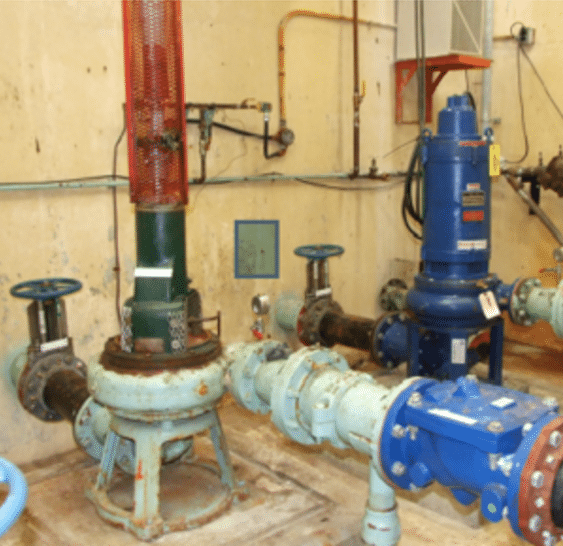Converting to a Dry Pit Submersible Pump
 You can find submersible pumps in many applications, including slurry pumping, general industrial pumping, sewage pumping, and drainage. The pump can either be lowered down wires or guide rails or connected to a pipe or flexible hose. Commercial and industrial markets heavily rely on these pumps’ unique advantages.
You can find submersible pumps in many applications, including slurry pumping, general industrial pumping, sewage pumping, and drainage. The pump can either be lowered down wires or guide rails or connected to a pipe or flexible hose. Commercial and industrial markets heavily rely on these pumps’ unique advantages.
In this post, we will take a look at converting a dry pit, otherwise known as a dry well, to be used as a submersible pump rather than a non-submersible pump. There are a lot of different advantages associated with this. Most importantly, a dry pit submersible pump will eradicate the requirement for a flexible drive shaft and help you protect against station flooding. Let’s take a look at the reasons why you should make the switch to a dry pit submersible pump.
Understanding Dry Pits and Submersible Pumps
A dry pit is a below-grade structure situated adjacent to a below-grade sump for holding wastewater and other types of liquid. The dry bit is the mechanical room where the pumps are installed to pump fluid out of the adjacent sump.
The most common modern municipal wastewater pump stations today use submersible pumps, which are directly submerged into the wastewater they are pumping. These sorts of pumps have been designed to replace the wet pit/dry pit configuration, which people used previously.
The change from the wet pit/dry pit configuration has been necessary because they demanded both a wet well and a dry vault, which meant that they were expensive to construct and costly to look after. The inefficiency of the wet pit/dry pit configuration has created a demand for submersible pump conversions.
With the wet pit/dry pit configuration approach, the dry pit is situated adjacent to the wet pit. The dry pit is where the pumps are installed. The wet-pit is a below-grade sump where the water is collected. The pumps located in the dry pit will take suction via the wet pit by piping, which will penetrate from the dry pit into the wet-pit.
Several different terms are used to describe the pumps installed into a dry pit, including non-clogs and solid-handling pumps. Alternatively, submersible pumps could also be installed into a dry pit, as long as there is some sort of cooling water circulating around the submersible motors, which requires external liquid for cooling purposes.
Converting to a Dry Pit Submersible Pump
There are several different benefits associated with dry pit submersible pumps when compared with traditional dry pit installations. These are advantages for both the user and the installer, and when it comes to the latter, these are typically passed onto you in the form of cost savings, so it works well for everyone involved.
For instance, they can present a low initial expense because they only incorporate the use of one pit, and you do not need as much auxiliary equipment as you would for a wet well/dry well installation.
Advantages of Converting to a Dry Pit Submersible Pump
There are several benefits that users can expect to experience by going down this route. Dry well submersible pumps provide a single, compact pump and a motor unit, which does not require a separate lubrication system. The unit does not need to be aligned, so it runs with less vibration, making it a lot quieter. Moreover, because the design is submersible, it is also flood-proof, which means it is ideal if there is any sort of disaster or power outage.
Now that you know about some of the benefits for the user, let’s take a look at some of the advantages you can expect from an installation perspective. Compared to typical wet well installations, dry well submersible pumps provide many benefits. It is easier for personnel to access the equipment for servicing and inspection, and of course, this makes the costs a lot lower for you, as well. This is the case because the professionals in question will not need to go into the wet well, which makes service easier and a lot cleaner as well.
C&B Equipment Can Help with Your Dry Pit Submersible Pump Conversions
If you would like help and assistance with converting to a dry pit submersible pump, please do not hesitate to contact our experienced and friendly team today for more information. We have helped many clients with dry pit submersible pump conversions, and we can replace Yeomans, Worthington, Smith & Loveless, Morris, Crane Deming, Clow, Chicago, Aurora, and Fairbanks Morse.
We pride ourselves on our efficient and reliable service, which is why we have been able to develop such a strong standing in the industry for so many years. We only use premium quality parts, yet you can be sure that our prices are some of the best that you will find. Plus, our friendly team is always happy to help.
C&B Equipment has many years of experience in the industry and will be more than happy to help you in any way that we can. Give us a call at (316) 262-5156 to talk to an expert and set up a consultation.
